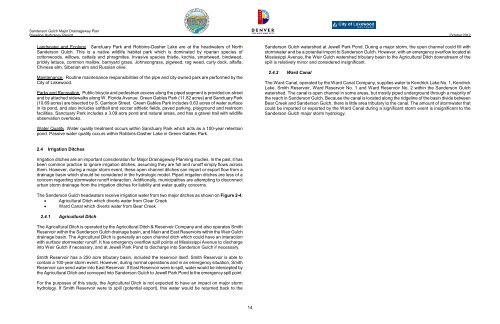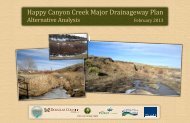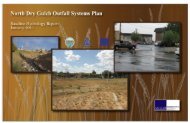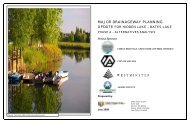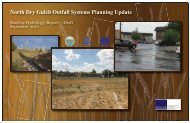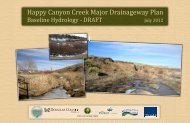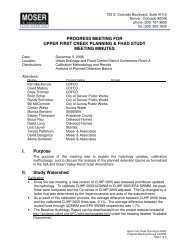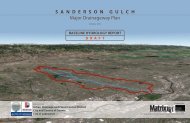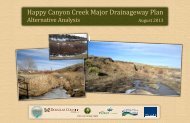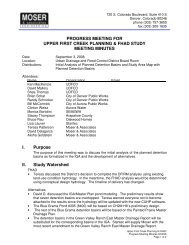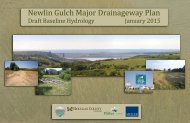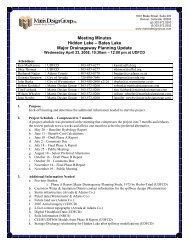Final Baseline Hydrology Report - October 2012 - Urban Drainage ...
Final Baseline Hydrology Report - October 2012 - Urban Drainage ...
Final Baseline Hydrology Report - October 2012 - Urban Drainage ...
You also want an ePaper? Increase the reach of your titles
YUMPU automatically turns print PDFs into web optimized ePapers that Google loves.
Sanderson Gulch Major <strong>Drainage</strong>way Plan<br />
<strong>Baseline</strong> <strong>Hydrology</strong> <strong>Report</strong> <strong>October</strong> <strong>2012</strong><br />
Landscape and Ecology. Sanctuary Park and Robbins-Dasher Lake are at the headwaters of North<br />
Sanderson Gulch. This is a native wildlife habitat park which is dominated by riparian species of<br />
cottonwoods, willows, cattails and phragmites. Invasive species thistle, kochia, smartweed, bindweed,<br />
prickly lettuce, common mallow, barnyard grass, Johnsongrass, pigweed, rag weed, curly dock, alfalfa,<br />
Chinese elm, Siberian elm and Russian olive.<br />
Maintenance. Routine maintenance responsibilities of the pipe and city-owned park are performed by the<br />
City of Lakewood.<br />
Parks and Recreation. Public bicycle and pedestrian access along the piped segment is provided on-street<br />
and by attached sidewalks along W. Florida Avenue. Green Gables Park (11.82 acres) and Sanctuary Park<br />
(10.69 acres) are bisected by S. Garrison Street. Green Gables Park includes 0.63 acres of water surface<br />
in its pond, and also includes softball and soccer athletic fields, paved parking, playground and restroom<br />
facilities. Sanctuary Park includes a 3.09 acre pond and natural areas, and has a gravel trail with wildlife<br />
observation overlooks.<br />
Sanderson Gulch watershed at Jewell Park Pond. During a major storm, the open channel could fill with<br />
stormwater and be a potential import to Sanderson Gulch. However, with an emergency overflow located at<br />
Mississippi Avenue, the Weir Gulch watershed tributary basin to the Agricultural Ditch downstream of the<br />
spill is relatively minor and considered insignificant.<br />
2.4.2 Ward Canal<br />
The Ward Canal, operated by the Ward Canal Company, supplies water to Kendrick Lake No. 1, Kendrick<br />
Lake, Smith Reservoir, Ward Reservoir No. 1 and Ward Reservoir No. 2 within the Sanderson Gulch<br />
watershed. The canal is open channel in some areas, but mostly piped underground through a majority of<br />
the reach in Sanderson Gulch. Because the canal is located along the ridgeline of the basin divide between<br />
Bear Creek and Sanderson Gulch, there is little area tributary to the canal. The amount of stormwater that<br />
could be imported or exported by the Ward Canal during a significant storm event is insignificant to the<br />
Sanderson Gulch major storm hydrology.<br />
Water Quality. Water quality treatment occurs within Sanctuary Park which acts as a 100-year retention<br />
pond. Passive water quality occurs within Robbins-Dasher Lake in Green Gables Park.<br />
2.4 Irrigation Ditches<br />
Irrigation ditches are an important consideration for Major <strong>Drainage</strong>way Planning studies. In the past, it has<br />
been common practice to ignore irrigation ditches, assuming they are full and runoff simply flows across<br />
them. However, during a major storm event, these open channel ditches can import or export flow from a<br />
drainage basin which should be considered in the hydrologic model. Piped irrigation ditches are less of a<br />
concern regarding stormwater runoff interaction. Additionally, municipalities are attempting to disconnect<br />
urban storm drainage from the irrigation ditches for liability and water quality concerns.<br />
The Sanderson Gulch headwaters receive irrigation water from two major ditches as shown on Figure 2-4:<br />
• Agricultural Ditch which diverts water from Clear Creek<br />
• Ward Canal which diverts water from Bear Creek<br />
2.4.1 Agricultural Ditch<br />
The Agricultural Ditch is operated by the Agricultural Ditch & Reservoir Company and also operates Smith<br />
Reservoir within the Sanderson Gulch drainage basin, and Main and East Reservoirs within the Weir Gulch<br />
drainage basin. The Agricultural Ditch is generally an open channel ditch which could have an interaction<br />
with surface stormwater runoff. It has emergency overflow spill points at Mississippi Avenue to discharge<br />
into Weir Gulch if necessary, and at Jewell Park Pond to discharge into Sanderson Gulch if necessary.<br />
Smith Reservoir has a 250 acre tributary basin, included the reservoir itself. Smith Reservoir is able to<br />
contain a 100-year storm event. However, during normal operations and in an emergency situation, Smith<br />
Reservoir can send water into East Reservoir. If East Reservoir were to spill, water would be intercepted by<br />
the Agricultural Ditch and conveyed into Sanderson Gulch to Jewell Park Pond to the emergency spill point.<br />
For the purposes of this study, the Agricultural Ditch is not expected to have an impact on major storm<br />
hydrology. If Smith Reservoir were to spill (potential export), this water would be returned back to the<br />
14


